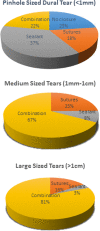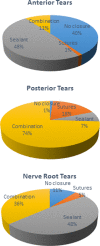Spinal Dural Repair: A Canadian Questionnaire
- PMID: 29977720
- PMCID: PMC6022961
- DOI: 10.1177/2192568217724132
Spinal Dural Repair: A Canadian Questionnaire
Abstract
Study design: Questionnaire.
Objectives: Iatrogenic dural tear is a complication of spinal surgery with significant morbidity and cost to the health care system. The optimal management is unclear, and therefore we aimed to survey current practices among Canadian practitioners.
Methods: A questionnaire was administered to members of the Canadian Neurological Surgical Society designed to explore methods of closure of iatrogenic durotomy.
Results: Spinal surgeons were surveyed anonymously with a 55% response rate (n = 91). For pinhole-sized tears, there is no agreement in the methods of closure, with a trend toward sealant fixation (36.7%). Medium- and large-sized tears are predominantly closed with sutures and sealant (67% and 80%, respectively). Anterior tears are managed without primary closure (40.2%), or using sealant alone (48%). Posterior tears are treated with a combination of sutures and sealant (73.8%). Nerve root tears are treated with either sealant alone (50%), or sutures and sealant (37.8%). Tisseal is the preferred sealant (79.7%) over alternatives. With the exception of pin-hole sized tears (39.5%) most respondents recommended bed rest for at least 24 hours in the setting of medium (73.2%) and large (89.1%) dural tears.
Conclusions: This study elucidates the areas of uncertainty with regard to iatrogenic dural tear management. There is disagreement regarding management of anterior and nerve root tears, pinhole-sized tears in any location of the spine, and whether patients should be admitted to hospital or should be on bed rest following a pinhole-sized dural tear. There is a need for a robust comparative research study of dural repair strategies.
Keywords: dural tear; durotomy; lumbar surgery; spinal surgery.
Conflict of interest statement
Declaration of Conflicting Interests: The author(s) declared no potential conflicts of interest with respect to the research, authorship, and/or publication of this article.
Figures
References
-
- Cammisa FP, Jr, Girardi FP, Sangani PK, Parvataneni HK, Cadag S, Sandhu HS. Incidental durotomy in spine surgery. Spine (Phila Pa 1976). 2000;25:2663–2667. - PubMed
-
- Epstein NE. The frequency and etiology of intraoperative dural tears in 110 predominantly geriatric patients undergoing multilevel laminectomy with noninstrumented fusions. J Spinal Disord Tech. 2007;20:380–386. - PubMed
-
- Fritsch EW, Heisel J, Rupp S. The failed back surgery syndrome: reasons, intraoperative findings, and long-term results: a report of 182 operative treatments. Spine (Phila Pa 1976). 1996;21:626–633. - PubMed
-
- Goodkin R, Laska LL. Unintended “incidental” durotomy during surgery of the lumbar spine: medicolegal implications. Surg Neurol. 1995;43:4–12. - PubMed
-
- Hodges SD, Humphreys SC, Eck JC, Covington LA. Management of incidental durotomy without mandatory bed rest. A retrospective review of 20 cases. Spine (Phila Pa 1976). 1999;24:2062–2064. - PubMed
LinkOut - more resources
Full Text Sources
Other Literature Sources




